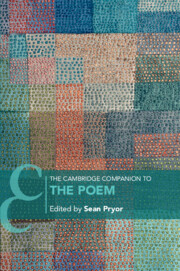Book contents
- The Cambridge Companion to the Poem
- The Cambridge Companion to the Poem
- Copyright page
- Contents
- Figures
- Contributors
- Acknowledgments
- Chronology
- Introduction
- Part I Ideas of the Poem
- Part II Forms of the Poem
- Part III The Poem in the World
- 13 Decolonizing the Poem
- 14 The Poem as World
- 15 The Poem and Its Audiences
- 16 The Poem in the Archive
- 17 The Poem and the Commodity
- 18 The Poem in the Digital Age
- Further Reading
- Index
- Cambridge Companions To …
15 - The Poem and Its Audiences
from Part III - The Poem in the World
Published online by Cambridge University Press: 30 May 2024
- The Cambridge Companion to the Poem
- The Cambridge Companion to the Poem
- Copyright page
- Contents
- Figures
- Contributors
- Acknowledgments
- Chronology
- Introduction
- Part I Ideas of the Poem
- Part II Forms of the Poem
- Part III The Poem in the World
- 13 Decolonizing the Poem
- 14 The Poem as World
- 15 The Poem and Its Audiences
- 16 The Poem in the Archive
- 17 The Poem and the Commodity
- 18 The Poem in the Digital Age
- Further Reading
- Index
- Cambridge Companions To …
Summary
This chapter approaches the problem of the poem's audience vis-à-vis the relational process of reading whereby one poem opens windows onto another, either through intertextual references and allusions or through the reader's own cognitive connections. The chapter expands on this relational ontology of poems to argue that in the act of reading there is no single poem; instead, a universal named “poetry” is extracted from the particularity of the so-called “single” poem. The chapter focuses on the poet-reader as a specific category of audience and, in order to read the transnational travel of poems, it considers the reception of T. S. Eliot in the works of Rabindranath Tagore and of the generation of Bengali poets who, after Tagore, both translate Eliot and echo him in their own poems. If Tagore is dissident in his use of Eliot's poetry as a counter-frame, the younger Samar Sen records a supportive intertextual presence of Eliot, while Bishnu Dey's translation of Eliot foregrounds a self-reflexivity of the poem that he imports into Eliot's text. These close readings affirm the chapter's central critique of the autonomous single poem in the pluralistic reading process.
Keywords
- Type
- Chapter
- Information
- The Cambridge Companion to the Poem , pp. 249 - 264Publisher: Cambridge University PressPrint publication year: 2024



